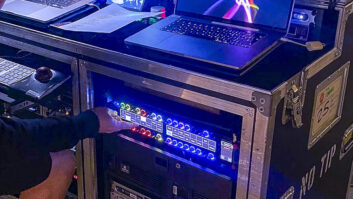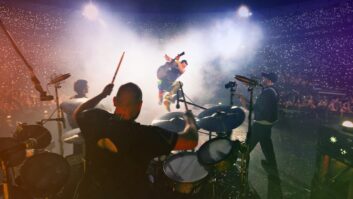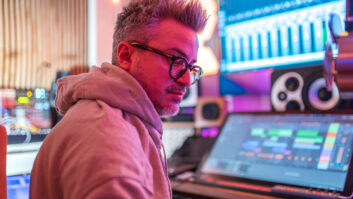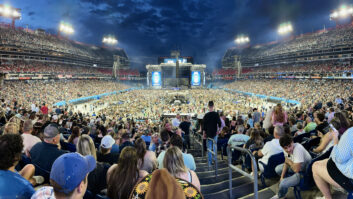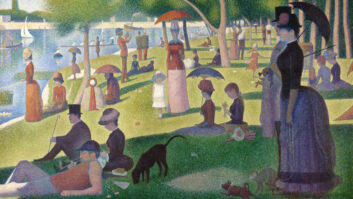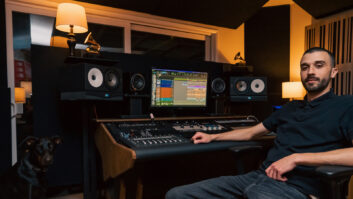Building on the success of hits like “Fix You,” “Yellow” and “Clocks,” Coldplay has become an international phenomenon over the last few years, and that, in turn, has paved the way for the U.K. group’s current “Twisted Logic” world tour in support of its X&Y album.
Setting down in the U.S., the band is rolling through arena dates across the country, before finishing up this month and heading off to Australia. While the tour is carrying a core audio team from the U.K. along for the ride, for the U.S. leg it was joined by crew and gear from Special Event Services (Winston-Salem, NC).
Key to the production is the SES-supplied L-Acoustics V-Dosc PA, kicking out the 105-109 dB sound level that FOH technician Brian Kiger asserts to be the norm. The rig consists of 54 V-Dosc boxes, with 15 per hang in the main clusters and 12 per hang on the sides. The tour also carries 18 dV-Dosc loudspeakers, placed variously on the tops or the bottoms of the clusters, depending on the shape of the room. Additionally, two-dozen L-Acoustics Arcs are hauled along to act as front fill. “They sell sometimes past 270 degrees,” explains Kiger, “and that’s the cluster of ARCs that flies behind the side of the V-Dosc cluster, covering the seats to the rear.” A total of 16 L-Acoustics SP 218s hang next to the main V-Dosc clusters and another 18 are on the ground.
Insuring that all those boxes cover the crowds every night is certified L-Acoustics V-Dosc technician, Tony Smith, who uses Array, an L-Accoustics program, to design the evening’s hangs, but the software is only the beginning: “I know the relationship between how it looks on paper and how it will translate to the room. The program acts as a jumping-off point in designing the sound coming from the array from the front row to the back row to get a nice, even coverage.”
Even so, they’re still open to suggestions. “If anything went wrong, the audience wouldn’t know, but we would notice,” clarifies Dave Cheek, the stage-right audio tech. “When Coldplay is up, I run around with a meter and make sure nothing is too loud, nothing weird is going on with the PA and I have to make sure the audience is happy. We like to listen to people, so we would take into consideration anything that an audience member would have to say.”
During the band’s stop at the Continental Airlines Arena in East Rutherford, NJ, the audience seemed very happy to sing along with the songs, “Talk” and “Fix You” from the new album, and were treated to bandleader Chris Martin running in the aisles. The sheer activity of the frontman alone has been the basis for the decision to use only wireless microphones from Shure rather that dealing with wired versions.
“Chris is all over the place, and it would be fairly cumbersome to have him on a wire,” says Kiger, speaking at the FOH position.That corner of the world is centered around a Midas XL-4 console chosen primarily for the sounds of the preamps. Kiger has it zoned out in six different parts of the system and combined with an XTA drive rack sporting outboard gear. Kiger explains, “The Lexicons are drum reverbs–we use a PCM90 for Chris’ vocal reverb, while the PCM70 is the drum reverb. Also, we’ll mix in different delays, and the Eventide H3000 is the voice doubler–which is what mostly everyone seems to use it for.”
One notable aspect of production is the fact that monitor world sits 5 feet below the stage with a foot-high view of the show through a gap in the staging. “A lot of other acts do it,” explains Cheek. “It’s a good idea to have it either below or behind the stage; that way you don’t see a lot of techs running around or the lights bouncing off the console itself. That way you can really focus on the band, especially if you are part of the audience. We enjoy it down here; we’re a bit removed from all the craziness that occurs during the show.”
Monitor engineer, Chris Wood, in turn, can concentrate solely on mixing and fine-tuning the 24 mixes that make up monitor world. Should any member of the band require adjustments during the show, they communicate through their techs–and that’s a good thing since the monitor area is positioned in such a small space. “Truth be told,” explains Wood, “the band can only communicate with me through a small gap.” Wood and techs have got the act down so well that the only adjustments that typically need to be made during the show involve raising or lowering guitar necks.
While many engineers use different equipment from tour to tour or between bands, Coldplay’s engineers reported that they’ve stayed relatively consistent with their gear, choosing to stick with tried and true bands that have worked in the past. Wood, for example, cannot even remember what he used prior to his Midas Heritage 3000 at stageside. That is not to say that any in the crew are resistant to change. “We want the best audio quality that we can come up with, and it’s been that way since the five years that I’ve been on board,” says Kiger. “If we come up with something that can make it better, we try to add that into the system.”
For such a large production, one would expect the crew to have its fair share of close calls or mishaps, however few or far between they may be. That’s not the case with this crew, as no one could remember any time in which something untoward has happened, other than tech Will Loudermilk bumping into Martin onstage as he switched out mics when the lights were down between songs. The audience never knew anyway, as both Martin and Loudermilk were back in their positions when the lights came back up. “We’ve done a lot of prep work, so nothing ever occurs that we can’t handle,” explains Kaylor. Wood pipes in, “We try to avoid any exciting things from happening; if there is a close call or anything like that, it means we’ve done our jobs badly.”
Special Event Services
www.specialeventservices.com

